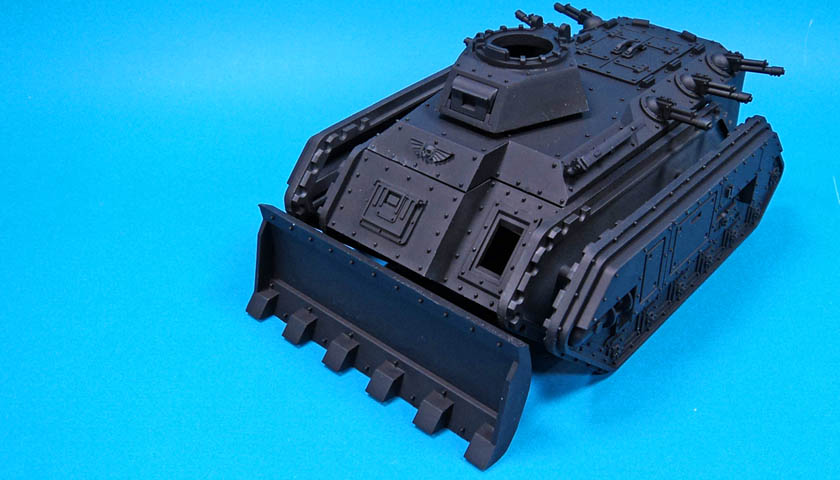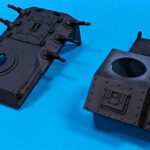While I have not felt any pull to actually play the Warhammer 40K table top game, I must say I am thoroughly enjoying Citadel’s models from that franchise. Though I’m still slogging through the figures for the Landspeeder Storm, I decided to go ahead and jump into my next 40K project – the Imperial Guard Chimera.
The basic back story on this is simple. The setting is the year 41,000, and everyone is angry and growling and likes to blow stuff up. So they need really cool vehicles to ride around in and growl and look angry in the midst of the blowing stuff up. Thus, we get these cool kits.
(Admittedly, that may be a bit of an oversimplification…)
😀
As for the kit, it’s really nice. The molding is very sharp, with the exaggerated detail that is part of the franchise. It’s perfect for applying any weathering and finishing techniques. None of this “petite panel line” and “subtle raised detail” nonsense. It’s in your face, dry brush away, add washes to your heart’s content, and rust the living snot out of it fun.
The parts breakdown is designed to allow a basic frame upon which several versions can be built. If this kit is any indication, Citadel has done it very nicely, with no annoying seams to give away the modularity of it. (Take note Hasegawa: it can be done!)
Multiple options are provided for a wide array of armaments. Various laser, cannon, flame thrower, and other things that go boom in support of the “blowing stuff up” theme are included. I’ve even seen quite a few builds by others that make use of magnets, so various parts can be swapped out. (A handy thing to know on future builds….)
So far, I’ve built the kit into various “modules” for priming and initial painting. I plan to leave the rear hatch functioning, so I’ll need to paint the interior of the hull prior to joining that up. And based on advice in several build videos, I’ve left the tracks off until the end.
And if you’re worried about the tracks – don’t be! They are nicely molded injection plastic parts, in multiple pieces. For the “flat” areas, you have a nice long run of tracks as a single piece, and around the curves, you have smaller pieces, shaped to fit the contours. (That reads like a woman’s undergarment commercial script… LOL) In other words – no snapping together forty bazillion little bits, or wrestling with those vinyl monstrosities. Paint them, weather them, slap them on.
While the kit’s box art shows a few color options, one for the “Cadians” (whoever they are, eh?) and one for the Catachans (whose mortal enemies are the Catachants), your choices are really unlimited.
(For those not in the know, like me, I think Cadians (Eh?) and Catachans are some of the angry shouting men in the far future who blow stuff up. They just dress different. Because of the reasons….)
What was I talking about?
The color options! Yes…
The color options are… unlimited. It’s made up nonsense. Paint it like it shows on the box. Paint it like a real world tank. Paint it purple and green and say it’s going to a planet full of singing dinosaurs to blow stuff up in angry fashion. (All the while singing “I hate you, you hate me…” 😀 )
Seriously though – you decide what to paint it. It is completely open. Even the decals provided are mere suggestions. If you’re into the lore of the Warhammer 40K world, there are many possibilities, depending on the environment you are imagining and the faction you like to model. And if you’re just building it for the fun of it, let your imagination run free. You know… that thing you did with your brain as a kid before joining the local Idiots Preventing Modeling Sanity chapter. (Oh, laugh, it’s funny…. I’ve been there, done that, have the mustard stained t-shirt…)
If you weren’t already aware, I’ve had a few cups of coffee this morning.
After the initial pre-assembly of various components, I primed everything with Badger’s Stynylrez Black Primer. And despite all my talk of “freedom!!!!” for painting it, I’m sticking with a basic Cadian (Eh?) two tone brown and green camo. Mainly because I plan to sell this, and I’m hoping sticking to a fairly canon scheme will help in those endeavors.
If you’re a bit tired of the rivet counting (or even rivet estimating) world that is “traditional” modeling, give one of these kits a try. While many of Citadel’s 40K kits are admittedly pricey, you can find quite a few for between US$20-$40. This kit was $39.99, so when compared with other kits I build, its pricing is not out of line. And while the parts count is lower, the fun to cost ratio is very, very good. In my book, that’s important. (Well… my book is actually more like a coloring book with scribbles, but you get the point.)
Next up will be painting the interior, sealing it all up, and getting to the exterior painting!








Leave a Reply